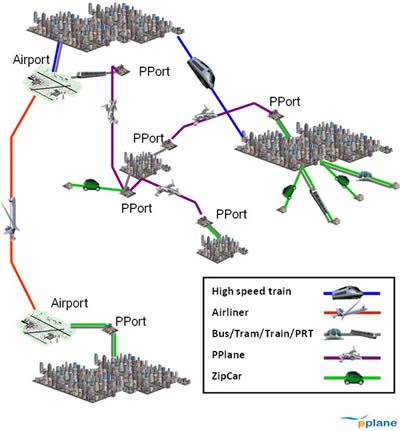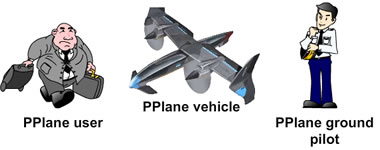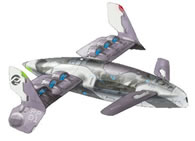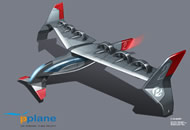After the Velib’, the Planelib’?
The purpose of the PPlane project is to explore an individual transport concept using automatic planes with few seats, for the general public. The challenge: supplementing the multimodal transport of the future with an air link to provide greater flexibility and speed.
Numéro 50 - [PPlane - the Personal Plane Project is a European project coordinated by Onera] [the Velib service in Paris]
|
|
Many science fiction works have said so: before the 21st century, we should all move around in flying cars or other individual aircraft. We are far from that: only a few very rich people have private jets, some keen pilots use small private planes or belong to flying clubs for travel or fun, and some people make do with shared planes. Also, the constraints in terms of energy, pollution and noise do not bode well for the development of individual aviation such as it is today. |
As part of its forward-looking research program, the European Commission launched a project called the PPlane in October 2009, in order to study the possibility of developing semi-individual aricraft, carrying two to eight people, for the general public. Onera is its coordinator.

The personal plane, the air link of a future multimodal transport system

In the PPlane concept, the pilot remains on the ground. He/she is in charge of the smooth operation of the flight, but it is the passenger who chooses the destination.
To see what this plane of the future might look like, researchers initially only took into account technical criteria, but they very quickly added social and environmental factors. With this, the number of solutions decreased drastically.  "It is unthinkable for this plane to be noisy or polluting” for example, explains Claude Le Tallec, A PPLANE conceptwho is in charge of the PPlane program at Onera. “It must therefore be electrical.” The other major issue is the degree of automation of this plane. “Many of partners in this project are pilots, who have a vision of leisure aviation”, says the researcher. “Here however, it is a case of transport that is within reach of most people, with a high safety requirement. It will thus be necessary for it to be highly automated, so that non-pilot passengers can use it.” These planes would thus be similar to drones, the only difference being that they would carry passengers. All of the current work on drone design, and their resistance to failures, is thus very useful for the PPlane.
"It is unthinkable for this plane to be noisy or polluting” for example, explains Claude Le Tallec, A PPLANE conceptwho is in charge of the PPlane program at Onera. “It must therefore be electrical.” The other major issue is the degree of automation of this plane. “Many of partners in this project are pilots, who have a vision of leisure aviation”, says the researcher. “Here however, it is a case of transport that is within reach of most people, with a high safety requirement. It will thus be necessary for it to be highly automated, so that non-pilot passengers can use it.” These planes would thus be similar to drones, the only difference being that they would carry passengers. All of the current work on drone design, and their resistance to failures, is thus very useful for the PPlane.
It is far too early to say whether such an individual air transport system is technically feasible, and still more to judge its economic relevance. The project is especially aimed at identifying the technical difficulties to be overcome. There are basically two: to design automatic systems capable of coping under any circumstances and to manufacture batteries with two or three times more duration.
Researchers are also trying to imagine how this plane will be used: Will it require take-off assistance? Will it take off from the city center, or from outside of the city like current planes do? What type of runway will it require and how long will it need to be? Will it be necessary to use a catapult? Will there be pilots and air traffic controllers on the ground, or only the latter? How should the flights be planned according to the weather? “While we have rather precise ideas for the plane technically, we are still unclear about its management,” Claude le Tallec specifies. What is a certainty is that such automatic planes are not compatible with the current air control system, which involves very little automation.
![The term PPlane in fact represents a system that includes the fleet aircraft and the pilots on the ground. This system interacts with air traffic control [ATC]](/sites/default/files/actualites/magazine/zoom_in_the_lab/50-pplane-atc-400.jpg)
The term PPlane in fact represents a system that includes the fleet aircraft and the pilots on the ground. This system interacts with air traffic control [ATC]
The PPlane consortium, consisting of five research centers, four universities and small and large industries, was ideally set up to guide its activities within the innovation perspective outlined by the European Commission.
The PPlane project already suggests a promising future for such an economically viable, socially acceptable and environmentally sustainable component of air transport in the 2050s. Achieving this future is nevertheless still dependent on research efforts, which should be continued, both in the technical and social areas.
